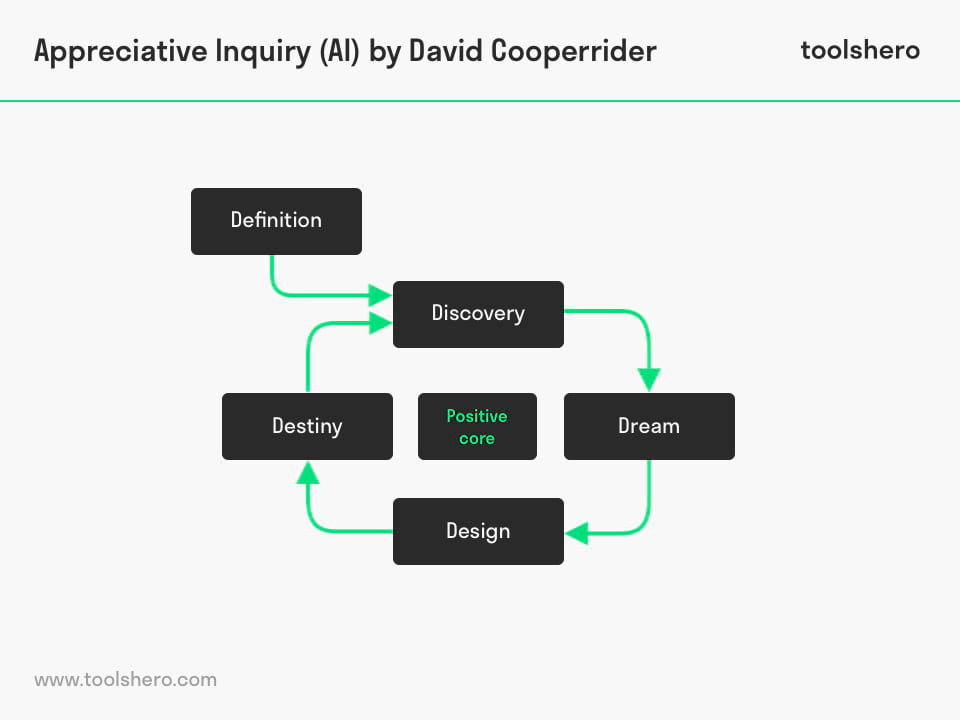Appreciative Inquiry model explained

Appreciative Inquiry: this article explains Appreciative Inquiry (AI), developed by David Cooperrider in a practical way. Next to what it (definition) is, this article also highlights how is it used in practice, the importance of positive core and human systems, the five principles, the Appreciative Inquiry model and that is an evolutionary process. After reading, you’ll have a basic understanding of this approach for leadership development. Enjoy reading!
What is Appreciative Inquiry?
When problems present themselves within an organization, an inquiry will be carried out first to find out what could be the cause of these problems, and subsequently these problems are solved as positive potential.
In Appreciate Inquiry it is all about the reverse process and here the emphasis is on positive change. The process of appreciate inquiry examines what brings out the best in people.
As a specialist in the area of organizational behaviour, David Cooperrider, Professorship in Appreciative Inquiry
Faculty Director, Fowler Center for Business as an Agent of World Benefit, researched the effect within organizations for this alternative approach to problem solving.
How is Appreciative Inquiry used in practice?
Appreciative Inquiry definition
Appreciative Inquiry is based on strength, and is a positive approach for leadership development, organisational change and organization development.
AI is used by teams, individuals, whole organisations, or on a societal level. In all cases, it helps people and companies evolve towards a shared future vision by involving others, as much as possible, in this kind of creative innovation.
An individual can use Appreciative Inquiry for leadership coaching or to develop a personal goal or vision.
Organisations and teams use AI to understand best practices, to change the company culture, to develop strategies, and to create momentum for large scale innovation projects. On a societal level, Appreciative Inquiry is used to find common ground for common interests, in order to then determine the direction for non-profit organisations and NGOs. More on this later.
Nowadays Appreciative Inquiry is used all over the world, in both private and public organisations. It is commonly known that British Airways has used Appreciative Inquiry to improve customer service, and Wal-Mart has used it in pursuit of sustainable value creation. The American navy has used it to develop leadership, and John Deere has used it to improve costs, quality, and cycle times.
Further on in this article, you will find various questions that can be used in order to develop using Appreciated Inquiry.
Positive core and human systems
In order to understand the so-called success factors of an organization, David Cooperrider developed a structured process named Appreciative Inquiry. All success factors together form the ‘positive core’ of an organization. The stronger this positives core, the better an organization is able to cope with all kinds of problems.
Appreciative Inquiry is oriented towards the controversial areas of positive psychology and karma (flow theory) and underlines all pluses of an organization instead of focusing on all of its failures.
Organisational development
The positive core of the organisational business is one of the best, yet one of the least recognised tools existing in the realm of change management.
Appreciative Inquiry shows that human systems primarily grow in the direction of linked studies. This tendency to grow is the strongest when the study’s resources and goals are positively correlated. In the Appreciative Inquiry process, the future is consciously built on the positive core elements of an organisation.
Linking the energy from this core to a change agenda creates momentum and mobilises resources, which were both never thought to be possible before.
The five Principles of Appreciative Inquiry(AI)
Appreciative Inquiry is based on five principles explained below.
Principle 1. The Constructionist Principle
As explained in the article about social interaction theory, reality as humans experience it consists primarily of social constructs.
The language we use shapes our social reality. The constructionist principle acknowledges that there are multiple ways to look at social reality. David Cooperrider says ‘absolutist claims, or the last word can be replaced by the never-ending collective search for understanding and constructing better life options’.
Everyday life is full of social constructs. These phenomena exist because people agree to them. Social status is an example of this, cash money is another. When people decide to change the common beliefs of a social construct, reality, as it is experienced by people, changes. This happened, among other things, in the financial crisis that started in 2008. People realised that credit cards were valuable assets that could serve as security for loans.
Organisations are also built up out of these kinds of social constructs. Consider assumptions, beliefs, rules, conventions, etc. These often remain undisputed and irrefutable. Decisions are made following a structure, and expectations for the future are shaped within the framework of these undisputed assumptions and beliefs.
Principle 2. The Poetic Principle
An organisation is quite similar to an open book. It is continuously written and re-interpreted, reviewed, and optimised. That is why there is no definite idea of what an organisation is, how it is, and what it is intended for.
Every new person who gets involved with an organisation is, so to speak, a new reader who brings his own perspectives to the table. Every new employee looks at the past, the present, and the future in the context of the organisation, and this is where a new source of learning and inspiration can arise.
Principle 3. The Simultaneity Principle
Change management is a widely studied discipline and includes various techniques and methods. Generally, the order of activities within the frame of change management within companies appears to be the following: collect data, analyse data, make recommendations, implementation.
Underlying this process is the assumption that there is a system that can be observed without being affected. There is, however, no such thing as a distant and objective analysis of organisational issues.
If patterns of social interaction and human organisation were not dictated by genes or determined by the external world, but instead constructed only in the context of relationships, the questions asked would become the new input of the new social system.
These questions have an effect on the listener, place certain images in their head, exclude others, and draw their attention to a certain path. Consider the following. A major company’s management can decide to collect information about problematic stress levels within the organisation.
Everyone within the company is asked to fill out a questionnaire, and some people are interviewed. The sources of stress, among other things, are discussed in the interviews, which clearly puts the subject in the forefront of everyone’s attention.
The employees who participate in the study think: ‘this is actually a pretty stressful work environment’. The stress level rises as a consequence of the study. This is mostly due to the staff’s distrustful nature towards the management’s intentions. Is the survey anonymous? Could my statements about stress factors in my department have negative consequences for me?
These legitimate questions start a change. That is the essence of the simultaneity principle.
Principle 4. The Anticipatory Principle
This principle is linked to the idea that vision inspires action. Human systems move in the direction of their vision of the future. The more positive the vision of the future, the more positive current actions will be.
It has been repeatedly proven that athletes who mentally practice success perform better than those who do not have a clear idea of what success would mean for them. Having a clear and convincing idea of the future leads to motivation, and motivation leads to vision.
Obviously, people also tend to distance themselves from bad experiences and fears, but the motivation to go where one wants to is often stronger and more sustainable than moving away from what one does not want to happen.
Principle 5. The Positive Principle
The positive principle is about asking positive questions to encourage positive change. Creating momentum for change is incredibly important, but requires a great deal of positive affection and social bonding. Momentum is best generated by asking questions and having the subject become a part of employees’ lives.
To enable change, people need to learn new ways of doing things. Often, change is stressful, and stress inhibits learning. So, major changes demand positive questions and tact.
What are the five stages? The Appreciative Inquiry model
A condition is the ‘provoking’ term of reference. By departing from a traditional term of reference, one can arrive at surprising perceptions and these help employees find their strengths and that of the organization. In this whole process of appreciative inquiry there are five stages:

Figure 1 – The Appreciative Inquiry Model (Cooperrider)
Stage 1. Affirmative Topic Choice (Definition)
The employees are interviewed by means of stimulating questions and create the definition. Themes are chosen from the answers and they will serve as focus areas.
Stage 2. Discovery
From the above-mentioned themes sub-themes are crystallized that reflect the success factors (positive core) of the organization.
Stage 3. Dream
By means of creative processes, creative solutions are looked for to change the organization in a positive way. It is about quantity of both usable and non-usable ideas, in which the release of creativity is the key element.
Stage 4. Design
How is the structure of the organization built up and classified? With the help of provoking statements, employees are obliged to formulate broad targets and ideas with the optimization of the organization in mind.
Stage 5. Destiny
By using the earlier stages, concrete plans will now be made and clear objectives will be formulated. The positive core serves as a guideline in this.
Appreciative Inquiry questions for teams and individuals
A part of the Appreciative Inquiry process is asking questions. This is called Appreciative Inquiry interviewing. Everyone can be an AI interviewer. You can also ask and answer the AI questions yourself.
Appreciative Inquiry questions for opportunities and possibilities
- How do your strengths and capabilities play a role in the project team?
- How does cooperation influence your personal output?
- What is the team focused on?
- What have you noticed from your team members in terms of skills?
Appreciative Inquiry questions for integration and cooperation
- Which of your strengths are used in your vision, and used together with other members’ strengths?
- In which situations do you use a strength that is typical for you?
- How are you going to use these strengths in future cooperations?
- How can you teach others what you know? And how can you learn from others?
Appreciative Inquiry questions for beliefs and values
- What have you noticed from your team members in terms of skills and behaviour?
- Which emotions or feelings have you noticed from your team members?
- What have you noticed from team members in terms of skills and behaviour?
- How do you manage your emotions? What about your colleagues’ emotions?
Appreciative Inquiry questions for leadership
- Think of a leader who inspires you. What are the various traits he or she has that stimulate excellence in you?
- Describe a moment in your career when you felt pride, involvement, or motivation. What did leadership contribute to that?
- What did you realise after your previous leadership experience?
Appreciative Inquiry questions for employee involvement
- Think of a company of which you think the stakeholders, such as staff, experience a sense of value and involvement. Which stakeholders are you considering? Staff? Customers?
- According to you, what does this company do to gets its employees so involved?
- What can we learn from them?
- How do you feel involvement in what you do for the organisation?
Appreciative Inquiry : Evolutionary process
The stages imitate the evolutionary process in many ways. The evolutionary process too is brought about by a selection of the most successful elements, that lay the foundations for the next stage in the development.
Except, in order to optimize companies, Appreciative Inquiry is also used for coaching and consultancy processes. It is a simple and pleasant way to come to an understanding of all positive qualities.
It’s Your Turn
What do you think? Is Appreciative Inquiry still applicable in today’s modern economy and management organizations? Do you recognize the practical explanation or do you have more suggestions? What are your success factors for the creation of a positive core of an organization?
Share your experience and knowledge in the comments box below.
More information:
- Barrett, F.J. & Fry, R.E. (2005). Appreciative Inquiry: A Positive Approach to Building Cooperative Capacity. Taos Institute.
- Cooperrider, D.L., Whitney, D. and Stavros, J.M. (2008). Appreciative Inquiry Handbook. Crown Publishing Group.
- Lewis, S., Passmore, J. & Cantore, S. (2008). The Appreciative Inquiry Approach to Change Management. Kogan Page.
How to cite this article:
Van Vliet, V. (2020). Appreciative Inquiry model. Retrieved [insert date] from Toolshero: https://www.toolshero.com/leadership/appreciative-inquiry/
Original publication date: 03/14/2020 | Last update: 08/22/2023
Add a link to this page on your website:
<a href=”https://www.toolshero.com/leadership/appreciative-inquiry/”> Toolshero: Appreciative Inquiry model</a>












